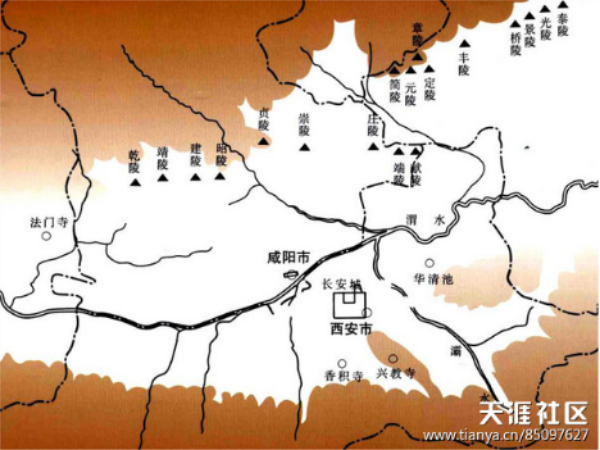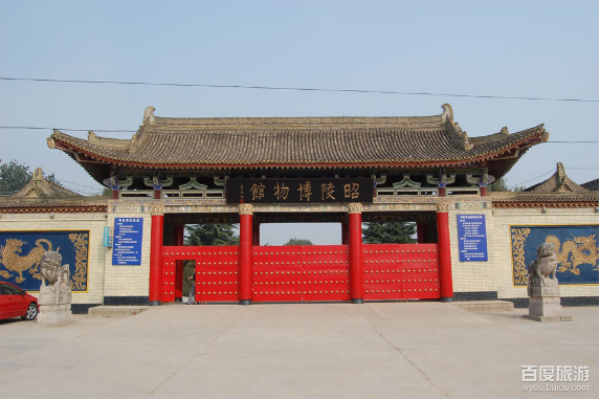Mausoleums of Tang Emperors

Locations of 18 Tang Emperors’ Mausoleums in Guanzhong Plain
Like the other emperors in ancient China, emperors of the Tang Dynasty (618~907AD) built their mausoleums at the high cost of labor, materials and finances. Apart from the mausoleum of Emperor Xuanzong in Henan Province and the mausoleum of Emperor Aidi in Shandong Province, the rest mausoleums of the emperors of the Tang Dynasty are all on the tableland to the north of Weihe River in Shaanxi, namely, Emperor Gaozu’s Xianling Mausoleum, Emperor Taizong’s Zhaoling Mausoleum, Emperor Gao Zong and his Empress Wu Zetian’s Qianling Mausoleum, Emperor Zhongzong’s Dingling Mausoleum, Emperor Ruizong’s Qiaoling Mausoleum, Emperor Xuanzong’s Tailing Mausoleum, Emperor Suzong’s Jianling Mausoleum, Emperor Daizong’s Yuanling Mausoleum, Emperor Dezong’s Chongling Mausoleum, Emperor Shunzong’s Fengling Mausoleum, Emperor Xianzong’s Jingling Mausoleum, Emperor Muzong’s Guangling Mausoleum, Emperor Jingzong’s Zhuangling Mausoleum, Emperor Wenzong’s Zhangling Mausoleum, Emperor Wuzong’s Ruiling Mausoleum, Emperor Xuanzong’s Zhenling Mausoleum, Emperor Yizong’s Jianling Mausoleum and Emperor Xizong’s Jingling Mausoleum. These mausoleums are in five counties and extend 150 kilometers from Qianling Mausoleum in the east to Tailing Mausoleum in the west. The tomb area is much lager than the tomb area in the Ming (1368~1644AD) and Qing (1644~1911AD) dynasties.

Zhaoling Mausoleum Museum
The Zhaoling Mausoleum and Qianling Mausoleums are two of the most representative among the 18 emperor mausoleums of the Tang Dynasty.
The Zhaoling Mausoleum is the mausoleum of Emperor Taizong (named Li Shimin), the second emperor of the Tang Dynasty. Located in Jiuzong Mountain to the northeast of Liquan County, Shaanxi Province, Zhaoling Mausoleum is 60 kilometers in circumference which is the largest of the 18 emperor mausoleums of the Tang Dynasty. With over 180 satellite tombs, the necropolis of Emperor Taizong covers an area of 200 square kilometers, the biggest imperial mausoleum in the world. The size of the mausoleum makes itself “most famous mausoleum” in the world. As a Chinese poem goes, “Standing at the highest point on the tableland and taking a overlook of Zhaoling Mausoleum”, the Zhaoling Mausoleum is so great and magnificent that we can see it clearly even from Chang’an 50 kilometers away in good weather.
Nestling against the side of Jiuzong Mountain, the Zhaoling Mausoleum set first example of tomb-making technique by means of chiseling cliff for the tomb. The necropolis is designed by the two brothers Yan Lide and Yan Liben who created the pattern of the necropolis according to the pattern in Chang’an. Integrated with buildings and sculptures, the mausoleum leans against the rolling hill. The buildings on the hill side are connected by plank roads which look like dancing dragon and flying phoenix from distance. The famous poet Du Fu described it as “a castle in the air” which impresses people deeply and leaves much room for imagination. Although the buildings on the ground are devastated at Zhaoling Mausoleum, there are still big quantities of precious cultural relics which are the testimony to prove the Tang Dynasty from weak to strong. It is also a treasure for people to understand the politics, economy and culture of the Tang Dynasty, even the whole feudal society of China.

A panoramic view of the Qianling Mausoleum
Located in Qianxian County, Shaanxi Province, Qianling Mausoleum is the only joint mausoleum for Emperor Gaozong and his Empress Wu Zetian. Built at the zenith of the Tang Dynasty, Qianling Mausoleum is a grand and imposing construction which earns the fame as “the most splendid emperor’s mausoleum in the history of China”.
The design of Qianling Mausoleum replicates the pattern in Chang’an City and perfects its layout in accordance with Zhaoling Mausoleum. It is composed of Imperial City, Inner Walls and Outer Walls, with a north-south going axis which is 4.9 kilometers long. Qianling Mausoleum was originally enclosed by two enclosures. There were four gates for the Inner City. The Inner City was in square shape. The north wall and south wall of the Inner City was 1,450 meters long respectively. The east wall was 1,582 meters long and the west wall 1,438 meters long. The circumference of the Inner City Wall is 40 kilometers. After the investigation, archaeologists claimed that the mausoleum covered an area of 2.3 million square meters. There were 60 buildings in the Inner City.

Qianling Mausoleum
The buildings were sacrificial halls, side halls, corridors, corner buildings and memorial halls for celebrities at that time. After the Anshi Rebellion in the Tang Dynasty, the buildings on the ground were devastated seriously. About 1,300 years after the fall of the Tang Dynasty, the buildings on the ground were all gone. Only more than 120 stone sculptures on both sides of the Sima Path (sacred way) are kept well which tell us a true story about the prosperous Tang Dynasty. The wordless tablet for Empress Wu Zetian and 61 stone statues for foreign envoys are the most representative ones.
Wu Zi Bei (the Wordless Tablet), is 7.53 meters high, 2.1 meters wide, 1.49 meters thick and 98.8 tons in weight. With delicate carving and imposing structure, the tablet is honored as the No.1 tablet by succeeding dynasties even though no word was carved on it when firstly built. Among various opinions about the reason why there is no word on the tablet, there are two different opinions about it. The first one goes: Empress Wu Zetian thought that her achievements were so great that they were beyond the description of words. The other one goes: Empress Wu Zetian would like to give the chance to people to make comments about her. During the 500 years from the Northern Song Dynasty to the Ming Dynasties (1103~1633AD), there were 39 visitors who wrote 42 pieces of panegyrics on the tablet. One of those panegyrics was a precious Khitan script, titled “Travel of the Military Commissioner of the Jin Dynasty”, which had been called a mystery in 21st century. The 61 stone statues for foreign envoys were ordered by Empress Wu Zetian in order to commemorate minority leaders and foreign envoys who attended the funeral ceremony for Emperor Gaozong. The stone statues reflect the great unity of different nationalities in the Tang Dynasty and it is the only place where people can see so many statues for just one emperor.
There are 17 burial tombs around Qianling Mausoleum. The tombs of Crown Prince Yide, Crown Prince Zhanghuai and Princess Yongtai are already excavated. The pottery figurines and murals in those tombs give us a lot of information about the heyday of the Tang Dynasty.
The Qianling Mausoleum is on the first list of the important historical sites for protection by Chinese government. It is put on the list for those places applying for the World Cultural Legacy along the Silk Road. Now, Qianling Mausoleum Museum which is located inside the Qianling necropolis for Emperor Gaozong, has become one of the most important emperor’s mausoleum museums in China.


